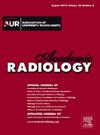SMART: Development and Application of a Multimodal Multi-organ Trauma Screening Model for Abdominal Injuries in Emergency Settings
IF 3.8
2区 医学
Q1 RADIOLOGY, NUCLEAR MEDICINE & MEDICAL IMAGING
引用次数: 0
Abstract
Rationale and Objectives
Effective trauma care in emergency departments necessitates rapid diagnosis by interdisciplinary teams using various medical data. This study constructed a multimodal diagnostic model for abdominal trauma using deep learning on non-contrast computed tomography (CT) and unstructured text data, enhancing the speed and accuracy of solid organ assessments.
Materials and Methods
Data were collected from patients undergoing abdominal CT scans. The SMART model (Screening for Multi-organ Assessment in Rapid Trauma) classifies trauma using text data (SMART_GPT), non-contrast CT scans (SMART_Image), or both. SMART_GPT uses the GPT-4 embedding API for text feature extraction, whereas SMART_Image incorporates nnU-Net and DenseNet121 for segmentation and classification. A composite model was developed by integrating multimodal data via logistic regression of SMART_GPT, SMART_Image, and patient demographics (age and gender).
Results
This study included 2638 patients (459 positive, 2179 negative abdominal trauma cases). A trauma-based dataset included 1006 patients with 1632 real continuous data points for testing. SMART_GPT achieved a sensitivity of 81.3% and an area under the receiver operating characteristic curve (AUC) of 0.88 based on unstructured text data. SMART_Image exhibited a sensitivity of 87.5% and an AUC of 0.81 on non-contrast CT data, with the average sensitivity exceeding 90% at the organ level. The integrated SMART model achieved a sensitivity of 93.8% and an AUC of 0.88. In emergency department simulations, SMART reduced waiting times by over 64.24%.
Conclusion
SMART provides rapid, objective trauma diagnostics, improving emergency care efficiency, reducing patient wait times, and enabling multimodal screening in diverse emergency contexts.
SMART:紧急情况下腹部损伤多模式多器官创伤筛查模型的开发与应用。
理由和目的:在急诊科进行有效的创伤护理需要跨学科团队利用各种医学数据进行快速诊断。本研究利用非对比计算机断层扫描(CT)和非结构化文本数据的深度学习构建了腹部创伤的多模态诊断模型,提高了实体器官评估的速度和准确性。材料和方法:收集腹部CT扫描患者的数据。SMART模型(筛选多器官评估快速创伤)使用文本数据(SMART_GPT),非对比CT扫描(SMART_Image),或两者都分类创伤。SMART_GPT使用GPT-4嵌入API进行文本特征提取,而SMART_Image则采用nnU-Net和DenseNet121进行分割和分类。通过SMART_GPT、SMART_Image和患者人口统计(年龄和性别)的逻辑回归,整合多模态数据,建立复合模型。结果:本研究纳入2638例患者(阳性459例,阴性2179例)。基于创伤的数据集包括1006例患者,1632个真实连续数据点用于测试。基于非结构化文本数据的SMART_GPT灵敏度为81.3%,受试者工作特征曲线下面积(AUC)为0.88。在非对比CT数据上,SMART_Image的灵敏度为87.5%,AUC为0.81,在器官水平上的平均灵敏度超过90%。集成SMART模型的灵敏度为93.8%,AUC为0.88。在急诊室的模拟中,SMART将等待时间减少了64.24%以上。结论:SMART提供快速、客观的创伤诊断,提高急诊护理效率,减少患者等待时间,并在不同的急诊情况下实现多模式筛查。
本文章由计算机程序翻译,如有差异,请以英文原文为准。
求助全文
约1分钟内获得全文
求助全文
来源期刊

Academic Radiology
医学-核医学
CiteScore
7.60
自引率
10.40%
发文量
432
审稿时长
18 days
期刊介绍:
Academic Radiology publishes original reports of clinical and laboratory investigations in diagnostic imaging, the diagnostic use of radioactive isotopes, computed tomography, positron emission tomography, magnetic resonance imaging, ultrasound, digital subtraction angiography, image-guided interventions and related techniques. It also includes brief technical reports describing original observations, techniques, and instrumental developments; state-of-the-art reports on clinical issues, new technology and other topics of current medical importance; meta-analyses; scientific studies and opinions on radiologic education; and letters to the Editor.
 求助内容:
求助内容: 应助结果提醒方式:
应助结果提醒方式:


